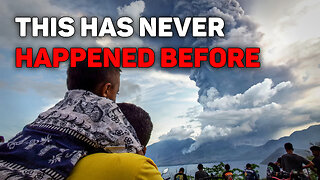Premium Only Content

No One Expected It: Lightning Changed the Course of the Game Forever!
In today’s review, you'll see the tragic events that millions of people around the world faced between October 30 and November 5, 2024. We'll also discuss measures that can help prevent such catastrophic consequences in the future.
The relentless force of nature continues to affect Spain, moving into new regions. While recovery teams in Valencia search for the bodies of those trapped in homes, on parking lots, and among crushed cars, torrential rains have shifted northeast, engulfing new areas.
A powerful eruption of Indonesia's Lewotobi volcano has resulted in at least 9 deaths, with 64 others injured, half of whom are in critical condition.
At the beginning of November, severe storms hit Israel, with northern areas experiencing flash floods, landslides, and hail. On the night of November 3, Oklahoma faced intense thunderstorms and at least five tornadoes.
On November 1, Cyclone Martina swept over the Scandinavian Peninsula and struck the Kaliningrad region of Russia, continuing further into the country.
On November 3, severe thunderstorms with fatal lightning strikes impacted northern Uganda, where 14 people lost their lives and 34 were injured at the Palabek refugee settlement.
That same day, a similar incident took place in Peru. During a soccer match, lightning struck the field, instantly killing one player. Seven others were injured, four of whom were hospitalized.
Intense rains caused flooding in the valleys of Syria’s northern and eastern regions. Starting October 30, large hail blanketed Saudi Arabian deserts, while heavy rains paralyzed life in Iraq beginning October 31.
On October 31, Super Typhoon Kong-rey made landfall on Taiwan’s coast. The disaster caused three deaths, injured nearly 700 people, and left over 970,000 households without power and more than 44,000 without water. Typhoon Kong-rey was Taiwan’s largest storm since 1996.
It’s clear today that humanity must prepare for massive natural challenges and implement collective safety measures.
A unified global disaster monitoring center, gathering worldwide data, is essential. Reliable alert systems must ensure that everyone receives timely information and safety instructions. Prepared evacuation centers with autonomous resources and cutting-edge rescue technology will be crucial in mitigating impacts.
But even with these emergency response measures in place, they may still fall short. Imagine if floods like those in Spain simultaneously hit dozens of countries. Humanity would face massive losses beyond what we could manage.
Global action is essential to minimize and, ideally, halt the escalation of these disasters. We have no other path but to seek solutions.
Science offers hope. An international team of scientists has already proposed a foundation for addressing the climate crisis and made initial developments. However, their efforts alone are insufficient. To effectively combat these threats, we must unite the world’s scientific potential, bringing together the best specialists and research institutions with one goal: preserving humanity.
Creating a Unified Scientific Center is possible only if there is political will. This will emerge only when people collectively voice their support and create a global demand.
We don’t know if this will happen, but as long as we see an OPPORTUNITY, we will pursue it. And we’d be glad to do so TOGETHER.
-
 14:51
14:51
Creative Society
12 days agoThe Moment EVERYTHING Changed: No One Expected an Eruption Like This!
682 -
 15:36
15:36
Neil McCoy-Ward
1 hour ago🚨 Emergency Martial Law Declared, Special Forces Deployed...
12.7K2 -
 LIVE
LIVE
The Charlie Kirk Show
1 hour agoDemocrat Billionaires in Crisis + Fixing the Migrant Crisis | Blagojevich, O'Brien, Metaxas| 12.3.24
8,240 watching -
 1:01:07
1:01:07
The Dan Bongino Show
4 hours agoBiden’s Reign Of Destruction Isn’t Over Yet (Ep. 2381) - 12/03/2024
611K1.27K -
 1:59:02
1:59:02
Steven Crowder
4 hours ago🔴 COVID Chronicles: The Hidden Truths of the Pandemic Exposed
336K181 -
 LIVE
LIVE
SoundBoardLord
3 hours agoMulti-Gen Don Juan in Full Force!
218 watching -
 1:08:54
1:08:54
MTNTOUGH Fitness Lab
3 hours agoSheriff Mark Lamb Exposes America’s Border Crisis and Cartel Infiltration | MTNT POD#93
8.75K1 -
 8:52
8:52
Cooking with Gruel
12 hours agoToasted Brown Butter Cornbread
10.8K -
 1:01:44
1:01:44
The Rubin Report
3 hours agoJon Stewart Loses His Cool with Democrats for Saying This About Hunter Biden Pardon
49.7K52 -
 1:52:47
1:52:47
Benny Johnson
3 hours agoLibs BACKSTAB 'Senile' Biden | Trump Tells Trudeau USA Is Going To Make Canada '51st State!’ 🇨🇦
60.1K68